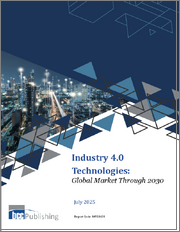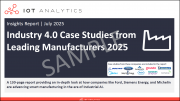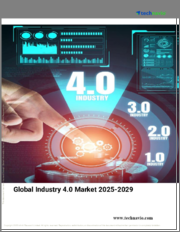
|
시장보고서
상품코드
1380445
세계의 인더스트리 5.0 시장(2023-2030년)Global Industry 5.0 Market 2023-2030 |
||||||
세계 인더스트리 5.0 시장은 예측 기간(2023-2030년) 동안 CAGR 17.8%의 성장률을 보일 것으로 예상됩니다. 인더스트리 5.0은 인공지능(AI)/머신러닝(ML), 빅데이터 분석, 사물인터넷(IoT) 등 첨단 기술과 인간 지능의 결합에 초점을 맞추었습니다. 점점 더 엄격해지는 환경 규제를 고려할 때 인더스트리 5.0은 기업이 지속 가능한 제조 공정과 제품에 초점을 맞추고 개인화 및 복원력을 향상시키는 데 도움이 될 것입니다. 이 외에도 시장 경쟁 심화, 개인화 제품에 대한 수요 증가, AI/ML, IoT, 클라우드 컴퓨팅의 기술 발전, 인더스트리 5.0에 대한 투자 증가, 정부 지원 증가 등이 이 분야의 성장을 가속하고 있습니다.
부문별 전망
제조업 부문이 세계 인더스트리 5.0 시장에서 상당한 점유율을 차지할 것으로 예상됨
산업별로는 제조업이 세계 인더스트리 5.0 시장에서 큰 비중을 차지할 것으로 예상됩니다. 제조업에 인더스트리 5.0을 적용하면 자동화 및 실시간 데이터 분석을 통해 업무 효율성을 향상시킬 뿐만 아니라 기계와 사람이 동시에 작업하여 프로세스를 개선하고 고객에게 개인화할 수 있습니다. 성장에 기여하고(세계 국내총생산의 17% 차지), 다른 부문 수요를 촉진하며, 고용 기회를 제공하고(근로자의 13% 직접 고용), 세계 무역의 상당 부분을 차지하는 등 경제에서 필수적인 역할을 하고 있습니다. 그러나 러시아와 우크라이나의 코로나19 사태와 같은 요인으로 인해 이 산업은 혼란에 빠졌고, 결국 기업과 정부는 운영 효율성 향상과 지속 가능한 제조에 집중할 수밖에 없게 되었습니다. 이에 따라 제조업체들은 수요를 충족하고 경쟁력을 유지하기 위해 인더스트리 5.0 방식을 채택하고 있습니다. 세계 경제에 대한 이 부문의 큰 기여, 세계화의 진전, 소비자 수요, 가처분 소득 증가, 기술 발전 등을 고려할 때, 제조 부문은 크게 성장할 것으로 예상됩니다.
지역별 전망
세계 인더스트리 5.0 시장은 북미(미국, 캐나다), 유럽(영국, 이탈리아, 스페인, 독일, 프랑스, 기타 유럽), 아시아태평양(인도, 중국, 일본, 한국, 기타 아시아 지역), 기타 지역(중동 및 아프리카, 라틴아메리카) 등 지역별로 세분화되어 있습니다. 더 세분화됩니다. 그 중에서도 유럽은 전자, 제약, 자동차, 기타 등 응용 분야의 높은 성장성으로 인해 세계 시장에서 두드러진 점유율을 차지할 것으로 예상됩니다. 예를 들어, 유럽자동차산업협회에 따르면, 이 지역의 2023년 8월 자동차 등록대수는 2022년 8월에 비해 21% 증가했습니다. 유럽의 자동차 생산 공장 수는 2021년 301개에서 2022년 322개로 증가했습니다. 이와는 별도로 국내 제조 및 공급망 부문의 성장과 엄격한 환경 규제로 인해 이 지역 시장 참여자들이 인더스트리 5.0 프로세스에 집중하면서 이 지역의 인더스트리 5.0 서비스 제공 업체에 대한 수요를 촉진하고 있습니다.
인더스트리 5.0 시장, 아시아태평양에서 크게 성장할 전망
세계 지역 중 인더스트리 5.0 시장은 아시아태평양에서 크게 성장할 것으로 예상됩니다. 유엔인구기금에 따르면, 이 지역은 세계 인구의 약 60%를 차지하며 4.6%의 성장률을 나타낼 것으로 예상됩니다. 이 지역의 국내총생산(GDP)과 가처분소득 증가는 제조업, 헬스케어, 전자제품, 자동차 등 다양한 분야에 대한 수요를 촉진하고 있습니다. 또한, 이 지역의 제조업은 낮은 인건비, 높은 소비자 수요, 다양한 정책적 지원, 투자, 지정학적 상황 변화 등의 요인으로 인해 크게 성장하고 있습니다. 예를 들어, 국제자동차산업협회의 2022년 통계에 따르면 중국, 인도, 일본, 한국은 연간 자동차 생산량에서 상위 5개국에 속합니다. 또한 이 지역은 세계 의약품 생산에서도 큰 존재감을 보이고 있습니다. 수요 증가, 경쟁, 엄격한 환경 규제를 배경으로 아시아태평양의 기업들도 인더스트리 5.0 프로세스를 채택하고 있습니다. 예를 들어, ABB 인도는 2022년 8월 벵갈루루의 넬라망갈라에 위치한 스마트 파워 공장을 확장하고 제품 수요를 충족시키기 위해 인더스트리 5.0 생산 공정을 도입하고 업그레이드했습니다. 회사 측에 따르면 인더스트리 5.0 프로세스 도입 후 생산성은 40%, 에너지 생산성은 15% 이상, 테스트 자동화 속도는 50% 증가했습니다.
목차
제1장 보고서 개요
- 업계 현황 분석과 성장 가능성 전망
- 조사 방법과 툴
- 시장 내역
- 부문별
- 지역별
제2장 시장 개요와 인사이트
- 조사 범위
- 애널리스트 인사이트와 현재 시장 동향
- 주요 조사 결과
- 추천 사항
- 결론
제3장 경쟁 구도
- 주요 기업 분석
- Rockwell Automation, Inc.
- 개요
- 재무 분석
- SWOT 분석
- 최근 동향
- Siemens AG
- 기업 개요
- 재무 분석
- SWOT 분석
- 최근 동향
- SAP SE.
- 개요
- 재무 분석
- SWOT 분석
- 최근 동향
- 주요 전략 분석
제4장 시장 세분화
- 세계의 인더스트리 5.0 시장 : 기술별
- 인공지능(AI)/머신러닝(ML)
- 로보틱스
- 사물인터넷(IoT)
- 빅데이터 분석
- 기타(디지털 트윈, 엣지 컴퓨팅, 양자 컴퓨팅)
- 기업 규모별
- 중소기업(SME)
- 대기업
- 세계의 인더스트리 5.0 시장 : 산업별
- 화학
- 제조업
- 헬스케어
- 에너지
- 소매
- 자동차
- 기타(정부, 물류, 공급망)
제5장 지역 분석
- 북미
- 미국
- 캐나다
- 유럽
- 영국
- 독일
- 이탈리아
- 스페인
- 프랑스
- 기타 유럽
- 아시아태평양
- 중국
- 인도
- 일본
- 한국
- 기타 아시아태평양
- 세계 기타 지역
제6장 기업 개요
- KUKA AG(a subsidiary of Midea Group Co Ltd.)
- Nexus Integra
- Microsoft Cooperation
- Mitsubishi Electric Corporation
- ECOSISTEMAS VIRTUALES Y MODULARES, SL
- Nfq Advisory SL
- Universal Robots A/S(subsidiary of Teradyne, Inc.)
- ORINOX
- Schneider Electric SE
- UnifyTwin Inc.
Title: Global Industry 5.0 Market Size, Share & Trends Analysis Report by Technology (Artificial intelligence (AI)/Machine learning (ML), Robotics, Internet of Things (IoT), Big data analytics, Others(Digital twins, Edge computing, Quantum computing)), by company size (Small and medium-sized enterprises (SMEs), Large enterprises), and by Industry (Manufacturing, Healthcare, Energy, Retail, Automotive, Others)Forecast Period (2023-2030).
The global Industry 5.0 market is anticipated to grow at a CAGR of 17.8% during the Forecast Period (2023-2030). Industry 5.0 focuses on the collaboration of advanced technologies such as Artificial Intelligence (AI)/Machine learning (ML), big data analytics, Internet of Things (IoT) with human intelligence. Considering growing stringent environmental regulations, industry 5.0 helps businesses focus on sustainable manufacturing processes and products and improves personalization and resilience. Apart from this, growing market competition, increasing demand for personalized products, technological advancements in AI/ML, IoT, and cloud computing, increasing investments in Industry 5.0 and growing government support are driving growth in this sector.
Segmental Outlook
The global industry 5.0 market is segmented on technology, company size, and industry. Based on the technology, the market is sub-segmented into Artificial intelligence (AI)/Machine learning (ML), robotics, Internet of Things (IoT), big data analytics, and other technologies such as Digital twins, Edge computing, and quantum computing. Based on company size the market is sub-segmented into small and medium enterprises (SMEs) and large enterprises. Based on industry, the market is sub-segmented into manufacturing, healthcare, energy, retail, automotive, and other industries such as government, logistics and supply chain. The healthcare sector is expected to hold a prominent share in the global industry 5.0 sector. According to Global Data Alliance, 94% of global Fortune 1000 companies reported supply chain disruptions due to COVID-19 in early 2020. Digital technologies such as data analytics, artificial intelligence (AI), and blockchain can support freight scheduling, sourcing, and inventory management, promote safety and fight counterfeiting, increase efficiency and resilience, reduce costs, and minimize disruption. Considering the benefits of Industry 5.0, companies are investing in technological advancements such as AI/ML for predictive analytics, cloud computing, and IoT to improve efficiency. For instance, In May 2023, SAP launched an AI solution logistics and supply chain industry named SAP Business AI in collaboration with Microsoft. In this partnership, SAP will integrate its solutions with Microsoft 365 Copilot and Azure OpenAI to help customers expand their logistic capabilities.
The Manufacturing Sub-Segment is Anticipated to Hold a Considerable Share of the Global Industry 5.0 Market
Among the applications, the manufacturing sub-segment is expected to hold a considerable share in the global industry 5.0 market. Application of Industry 5.0 in manufacturing can allow the industry to improve operational efficiency by automation and real-time data analysis but also allow human presence to work alongside machinery to improve processes and provide personalization for customers. According to the World Manufacturing Report of 2022, the manufacturing industry plays an essential role in the economy, contributing to economic growth (representing 17% of global gross domestic product), boosting demand in other sectors, providing employment opportunities (directly employing 13% of workers), and representing a considerable share of global trade. However, the industry witnessed disruption due to factors such as the Russia-Ukraine warm COVID-19 eventually forcing companies and governments to focus on improving operational efficiency and sustainable manufacturing. For this, manufacturers are adopting industry 5.0 methodology to meet demands and stay competitive. Considering the significant contribution of this sector to the global economy, growing globalization, and consumer demand, increasing disposable income, and technological advancements, the manufacturing sector is expected to grow significantly.
Regional Outlook
The global industry 5.0 market is further segmented based on geography including North America (the US, and Canada), Europe (UK, Italy, Spain, Germany, France, and the Rest of Europe), Asia-Pacific (India, China, Japan, South Korea, and Rest of Asia), and the Rest of the World (the Middle East & Africa, and Latin America). Among these, Europe is anticipated to hold a prominent share of the market across the globe, owing to the high growth potential of the application sector including electronics, pharmaceuticals, Automotive, and others. For instance, according to the European Automobile Manufacturers' Association, the region saw 21% more registrations of cars in August 2023 as compared to August 2022. The number of automobile production plants in Europe has increased from 301 in 2021 to 322 in 2022. Apart from this growing domestic manufacturing and supply chain sector and stringent environmental regulations are pushing regional market players to focus on industry 5.0 processes which is driving demand for industry 5.0 services providers in the region.
The industry 5.0 Market is Expected to Grow significantly in Asia Pacific Region
Among all regions, the industry 5.0 market is expected to grow significantly in the Asia Pacific region. According to the United Nations Population Fund, the region holds approximately 60% of the global population and is expected to grow at 4.6%. The growing regional Gross Domestic Product (GDP) and disposable income are driving demand for multiple sectors such as manufacturing, healthcare, electronics, and automotive among others. The regional manufacturing sector is also growing significantly due to factors such as low labor costs, high consumer demand, increasing government support through various policies, investments, and changing geopolitical conditions. For instance, according to 2022 statistics, of the International Organization of Motor Vehicle Manufacturers China, India, Japan, and South Korea are among the top 5 countries in in annual automotive manufacturing. Additionally, the region holds a significant presence in global pharmaceutical manufacturing. With growing demand, competition, and stringent environmental regulations, the companies in Asia Pacific are also adopting industry 5.0 processes. For instance, in August 2022, ABB India expanded and upgraded its Smart Power factory in Nelamangala, Bengaluru, with industry 5.0 production processes to meet demand for its products. The company said its Productivity was enhanced by 40%, energy productivity by more than 15%, and test automation ratio by 50% after the implementation of industry 5.0 processes.
Market Players Outlook
The major companies serving the industry 5.0 market include: Rockwell Automation, Inc., KUKA AG, Siemens AG, Nexus Integra, Microsoft Corporation, and others. The market players are considerably contributing to the market growth by the adoption of various strategies investing in research and developments, and providing personalized solutions, to stay competitive in the market. For instance, In May 2022, UnifyTwin announced the launch of an Intelligent industrial App suite that offers five business apps to address various aspects of the industrial life cycle driving towards sustainable business outcomes.
The Report Covers:
- Market value data analysis of 2022 and forecast to 2030.
- Annualized market revenues ($ million) for each market segment.
- Country-wise analysis of major geographical regions.
- Key companies operating in the global industry 5.0 market. Based on the availability of data, information related to new product launches, and relevant news is also available in the report.
- Analysis of business strategies by identifying the key market segments positioned for strong growth in the future.
- Analysis of market-entry and market expansion strategies.
- Competitive strategies by identifying 'who-stands-where' in the market.
Table of Contents
1. Report Summary
- Current Industry Analysis and Growth Potential Outlook
- 1.1. Research Methods and Tools
- 1.2. Market Breakdown
- 1.2.1. By Segments
- 1.2.2. By Region
2. Market Overview and Insights
- 2.1. Scope of the Report
- 2.2. Analyst Insight & Current Market Trends
- 2.2.1. Key Findings
- 2.2.2. Recommendations
- 2.2.3. Conclusion
3. Competitive Landscape
- 3.1. Key Company Analysis
- 3.2. Rockwell Automation, Inc.
- 3.2.1. Overview
- 3.2.2. Financial Analysis
- 3.2.3. SWOT Analysis
- 3.2.4. Recent Developments
- 3.3. Siemens AG
- 3.3.1. Overview
- 3.3.2. Financial Analysis
- 3.3.3. SWOT Analysis
- 3.3.4. Recent Developments
- 3.4. SAP SE.
- 3.4.1. Overview
- 3.4.2. Financial Analysis
- 3.4.3. SWOT Analysis
- 3.4.4. Recent Developments
- 3.5. Key Strategy Analysis
4. Market Segmentation
- 4.1. Global Industry 5.0 Market by Technology
- 4.1.1. Artificial intelligence (AI)/Machine learning (ML)
- 4.1.2. Robotics
- 4.1.3. Internet of Things (IoT)
- 4.1.4. Big data analytics
- 4.1.5. Others (Digital twins, Edge computing, Quantum computing)
- 4.2. By company size:
- 4.2.1. Small and medium-sized enterprises (SMEs)
- 4.2.2. Large enterprises
- 4.3. Global Industry 5.0 Market by Industry
- 4.3.1. Chemicals
- 4.3.2. Manufacturing
- 4.3.3. Healthcare
- 4.3.4. Energy
- 4.3.5. Retail
- 4.3.6. Automotive
- 4.3.7. Others (Government, Logistics, and supply chain)
5. Regional Analysis
- 5.1. North America
- 5.1.1. United States
- 5.1.2. Canada
- 5.2. Europe
- 5.2.1. UK
- 5.2.2. Germany
- 5.2.3. Italy
- 5.2.4. Spain
- 5.2.5. France
- 5.2.6. Rest of Europe
- 5.3. Asia-Pacific
- 5.3.1. China
- 5.3.2. India
- 5.3.3. Japan
- 5.3.4. South Korea
- 5.3.5. Rest of Asia-Pacific
- 5.4. Rest of the World
6. Company Profiles
- 6.1. KUKA AG (a subsidiary of Midea Group Co Ltd.)
- 6.2. Nexus Integra
- 6.3. Microsoft Cooperation
- 6.4. Mitsubishi Electric Corporation
- 6.5. ECOSISTEMAS VIRTUALES Y MODULARES, SL
- 6.6. Nfq Advisory SL
- 6.7. Universal Robots A/S (subsidiary of Teradyne, Inc.)
- 6.8. ORINOX
- 6.9. Schneider Electric SE
- 6.10. UnifyTwin Inc.



















